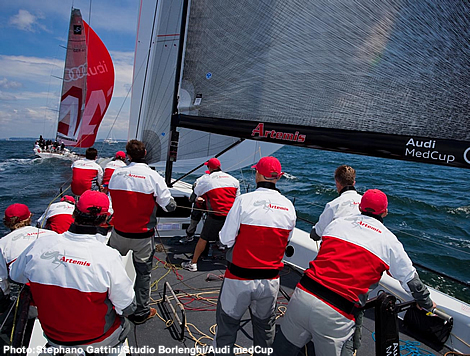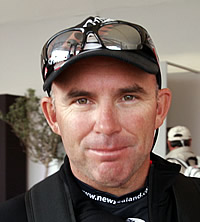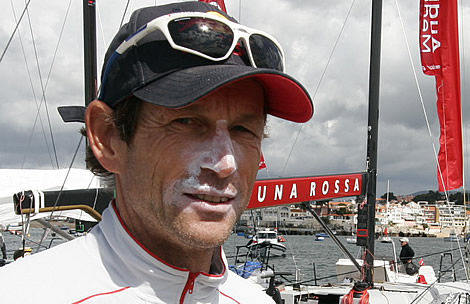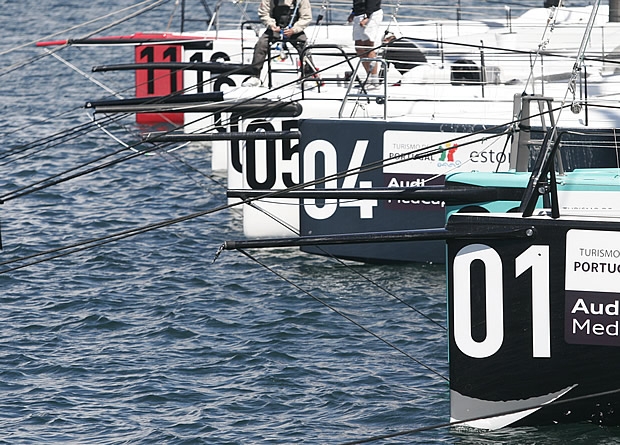A whole new game
The TP52s have undergone some significant changes over the winter, turning them from a boat clearly born of IMS to something more modern and 2010 with the replacement of the spinnaker pole in favour of a bowsprit and the old single backstay set-up with twin backstays allowing for a larger roach and a flat top to the mainsail.
However the change to twin backstays in particular is something the teams have undertaken in different ways. As Nick Bice showed us in our guided tour to TeamOrigin 1851, the only new boat built for this season (and the only Juan Kouyoumdjian design), they have two chain plates for each of their running backstays, moving it to the outboard position when the breeze is up. Some, such as Artemis have gone down the low hassle, low weight gain route and stuck with the existing single backstay structure, by having their twin chainplates close to the centre line of the boat, while others have made a structural change to the back of the boat so their chainplates for the runners can be located further outboard.

 But there is more to it than even that, as Emirates Team New Zealand tactician Ray Davies explains: “There are two backstays, but whether you go to a bigger or smaller winch and what purchase system you use differs from boat to boat. If you look at our boat we have a lock on the dead end, so you can still adjust that quite quickly, but the key is to be able to have the runner man still work the runner while he’s hiking to get maximum weight out. Some boats don’t have enough purchase in their system so that they have to sit in and over the top of it. So we are happy with ours in a straight line, you have the guys hiking and they can still play with the top mast. So our system is quite complicated, but it works really well.”
But there is more to it than even that, as Emirates Team New Zealand tactician Ray Davies explains: “There are two backstays, but whether you go to a bigger or smaller winch and what purchase system you use differs from boat to boat. If you look at our boat we have a lock on the dead end, so you can still adjust that quite quickly, but the key is to be able to have the runner man still work the runner while he’s hiking to get maximum weight out. Some boats don’t have enough purchase in their system so that they have to sit in and over the top of it. So we are happy with ours in a straight line, you have the guys hiking and they can still play with the top mast. So our system is quite complicated, but it works really well.”
With the bowsprits, the boats are using exclusively asymmetric kites downwind, but a further change this year is that on all the boats they have ‘string drop’ systems down below (as used on AC boats, Mini-Maxis, etc) so the ‘string’ goes from the centre of the kite, down through the forehatch, does a loop to the back of the boat and forward again, then up into the cockpit on to a winch, powered by the grinders. Thus kite drops take place in the blink of an eye.
This and the drop in crew numbers for this season has required teams to reappraise their crew roles.
For the most part, crew numbers have also dropped by three and in the case of Emirates Team New Zealand this has seen the ‘old guys’ – Grant Dalton and his no2 Kevin Shoebridge - off the boat along with Stu Bettany, although Davies reckons Dalton will sail from time to time this season. “We have juggled things around on the boat. Jeremy Lomas has come off the bow and into the pit and Adam [Beashel] as the strategist has a lot more of a floating role. He is more involved in the crew work side of things.”
On Artemis Jared Henderson reckons that they could have shed even more crew. “They were over crewed before hand and you could even sail with less if you wanted to. So the strategist role has become more of a floater/backstay type role. There is no mastman, because there is no pole.”
Cristabella boat captain Brendan Darrer explains the crew changes they have made: “For us I guess you no longer say you are a ‘bowman/pitman/trimmer’. You are 12 people who sail the boat and there is a lot of multi-tasking, like our bowman lets the jib go upwind. I am the pitman, but I do an awful lot of grinding! Down hill trimmer trims the backstay uphill. It is more fun.”
Following their mast breakage towards the end of last season, Cristabella is the only boat, aside from the all-new TeamOrigin 1851, to have a new mast – but while their British rivals have gone for the Southern Spars option, Cristabella has a new HallSpars rig. This season they have also changed to Quantum Sails (there are now three Quantum boats on the Audi MedCup’s TP52 fleet – Quantum Racing, Cristabella and the Russian boat Synergy) and they have their sail designer Dave Armitage on main sheet.
Unusually on Alberto Roemmers’ Matador they have managed to get away with only shedding two crew. “That extra person we have is because we are all quite small!” explains Argentinian Tornado Olympic medallist Santiago Lange, who is sailing on board this year as strategist.
Surprisingly, given the retirement of the spinnaker pole, the TP52s this year are more physical to sail. While there may be less foredeck work, the grinding job has increased (as is the trend throughout the big boat world) and there is more use of kinetics (check out our on board TeamOrigin video). However a major change this year is that an ‘open pumping’ rule has been introduced, similar to that used in Olympic classes, notably the Finn.
“It is straightforward – over 13 knots the race committee can put a flag up on the downwind legs that unlimited pumping is allowed,” explains Davies. “So gennikers and mainsails are flapping all the way downwind, which is very cool, because these boats respond to a lot of physical work downwind. So it is good for the boats, and it makes it hard work for the crews, which is also good. Before it was always a grey area and it was hard for the jury to cover all the boats especially once we start spreading out. So the flag goes up and away you go.”
So with unlimited pumping it is likely that teams have been looking at not only techniques, but gear they can use to aid this. As Davies puts it – “low gearing of the pedestals and some big guys working hard”.
The free pumping rule came about after discussion with the teams and Santi Lange says the Matador crew were initially in two minds about it. “To pump you need to have a good technique. If we get waves we want to see how the teams have developed that free pumping, but it is good because you don’t get disqualified for pumping. You get an O flag and then you are free to pump. It is like all the Olympic classes. I think it is good that the sport gets more athletic and the technique is very important.”

Lange also points out that manning the twin backstays during manoeuvres has become an additional role for the crew this year. “With the single backstay in the past you didn’t have to ease that off out of a tack - it was always on. Now it is more physical for the guys grinding that up upwind. So the boats are a lot tougher to sail.”
With the changes – the additional horsepower from the kites and a marginal increase in bulb weight so the performance of the boats has taken a hike. Lange says: “I think the boat is quicker in up to 13-14 knots of wind, compared to last year. Upwind and downwind as well we are a touch quicker. The bigger sail area is helping. They are little changes – nothing enormous.”
The performance improvement is set to be substantially greater next year when there will be a new generation of TP52s allowed substantially larger bulbs.











Latest Comments
Add a comment - Members log in